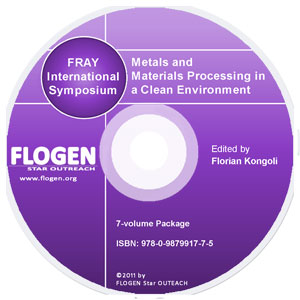
CD shopping page |
2011-Sustainable Industrial Processing Summit
|
| Editors: | Florian K |
| Publisher: | Flogen Star OUTREACH |
| Publication Year: | 2012 |
| Pages: | 708 pages |
| ISBN: | 978-0-9879917-1-3 |
| ISSN: | 2291-1227 (Metals and Materials Processing in a Clean Environment Series) |
Effect Of Chlorides Into The Raw Materials On Pcdd/F Emissions Of Large Sintering Machine With Process Gas Recovering
Jose Adilson Castro1;1FEDERAL FLUMINENSE UNIVERSITY, Volta Redonda, Brazil;
Type of Paper: Regular
Id Paper: 256
Topic: 5
Abstract:
The iron ore sintering technology is a well established process in use at the integrated steel plant. The process is complex involving various physical and chemical phenomena. The raw materials used can vary to a wide extent, from iron ore to dust and solid residues from the steel plant. The process takes place in a moving strand where a mixture of iron ore (sinter feed), fine coke, limestone and water is continuously charged to form a thick bed of approximately 80cm. Along the first meters of the strand the charge is ignited by gas burners. The hot gas, generated by the combustion of natural gas with air, is then sucked in through the packed bed from the wind boxes placed below the grate. The combustion of coke breeze or alternative fuels begins at the top of the layers, and as it moves, a relative narrow band of ignition zone moves down through the bed. Several chemical reactions and phase transformations take place within the bed, part of the materials melt when the local temperature reaches the melting temperature and as it moves, the solidification process is completed. The partial melting and diffusion within the materials promotes the particle agglomeration forming a porous sinter cake. Recently, it has been proposed to reuse the outlet gas with a preconditioning system which use a gas fuel like coke oven or natural gas which furnish preheating gas and heat input to the sintering zone. The physicochemical and thermal phenomena involved are complex and numerous. Special mention is made to the phenomena of gas flow through the porous bed, gas-solid heat transfer, drying and several chemical reactions and phase transformations1-3). When recycling solid waste a special concern is due to the chlorides presents into the solid wastes which decomposes into the bed and can be precursor of PCDD/F3-5). In this analysis 5 tests of raw materials are considered: i) base case of actual operation; ii) 5 t/h of solid waste with 1.5% of chlorites with conventional operation practice; iii) 5 t/h of solid waste in the mix of raw materials with 3% of chlorites; iv) 5 t/h of solid waste with 3% of chlorites and precondioned gas at 600 oC and 5% of CO2 and 2%of CH4; v) 5 t/h of solid waste with 3% of chlorites and preconditioned gas at 600 oC and 5% of CO2 and 5% of CH4. The above cases were tested in a multiphase mathematical model which takes into account coupled phenomena of momentum, energy and chemical reactions. The model predictions indicated that in all cases wider sintering zones are obtained and the formation of calcium ferrite are increased. The productivity of the sinter strand could be increased and the proposed amount of waste solid recycling would not strongly affect the total amount of PCDD/F generation. In the cases of gas recycling the total amount of PCDD/F decreased